Robert Campbell constructed a water-powered sawmill at Mill Creek about 1790, being the first of its kind in northern Michigan. Prior to the mill, trees were turned into lumber entirely with hand tools for more than 100 years at the Straits of Mackinac.
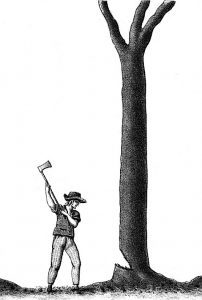
Traite de l’art du Charpentier (1804)
British troops constructed Fort Mackinac on Mackinac Island from 1779-1781. Some buildings were dismantled at Fort Michilimackinac on the mainland and transported to the island for reconstruction. Without a sawmill nearby, new construction relied on chopping down trees, sawing them into logs, squaring them with axes, and hauling them to a sawpit where boards were produced. A glimpse of this work can be found in the Log Book of His Majesty’s Armed Sloop – Welcome, kept by Captain Alexander Harrow.
Beginning in 1779, the Welcome sailed between the lower peninsula mainland and Mackinac Island, hauling buildings, supplies, and timber. On November 19, 1780, Captain Harrow wrote, “This morning blowing hard. Discharged our timber and hauled it up along side of the sawpit. This day snowing very hard… All this day snowing very hard.”
The Welcome remained tied to a wharf on Mackinac Island throughout the winter of 1780-1781. The crew lived on board and worked each day hauling firewood, sawing planks, repairing the ship, and constructing a blockhouse at the fort.
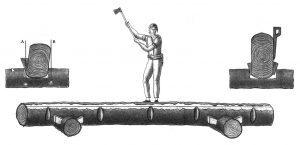
Turning a tree into lumber by hand is demonstrated each summer at Historic Mill Creek. After a log is fixed in place, one rounded side is hewed with a felling axe, then flattened with a broad axe. After these actions are repeated on each side, a round log is transformed into square timber. If desired, timbers could be flattened further with an adze to produce a finer surface.

To fashion planks and boards, a squared timber is either placed over an open sawpit dug into the ground or hoisted overhead on large sawhorses. To cut boards, a pit sawyer climbs into the hole to pull down on a large saw, while a top sawyer balances above, pulling up on the blade and guiding a straight cut. Despite the unforgiving rocky terrain, several saw pits were dug on Mackinac Island during the construction of Fort Mackinac.
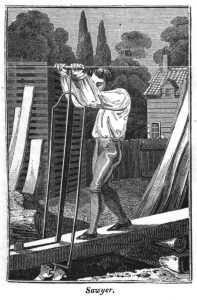
English Book of Trades (1824)
Captain Harrow noted his men were at work sawing boards on Mackinac Island more than 50 days from November 1780 – April 1781. He specifically mentioned saw pits many times, including,
“… put a log on the pit to saw” (Nov. 29)
“…hauling logs to the saw pit” (Dec. 27)
“…hauling plank from the saw pit to the blockhouse” (Dec. 29)
“…making a saw pit in the woods and getting an oak log on it” (Jan. 16)
“…digging and making a new saw pit” (Feb. 20)
Warm spring weather finally released the icebound sloop and the Welcome set sail on April 24, 1781. One of the crew’s tasks was making trips to “The Pinery,” a camp located about 15 miles north of Saint Ignace, near the mouth of the Pine River. There, a team of men cut logs then rafted them together on Lake Huron. These rafts were towed behind the Welcome to Mackinac Island, where they were broken up, individual logs hauled to sawpits, and sawn into boards.
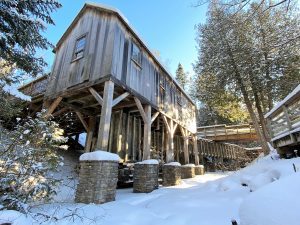
A decade after Fort Mackinac was constructed, sawing boards by hand could not keep pace with local demand for lumber. About 1790, Robert Campbell was granted a 640-acre land claim at Mill Creek, the only stream at the Straits powerful enough to operate a water-powered sawmill. Later owned by Michael Dousman, the sawmill at Mill Creek operated for nearly 50 years before closing in 1839.
When the sawmill at Mill Creek was abandoned, large trees throughout the Straits region had been harvested for nearly 150 years. As young trees grew in their place, they too were eventually cut in subsequent periods of logging. In 1860, William Johnston wrote, “the trees now seen [on Mackinac Island] are the second and third growth.” In a History of Northern Michigan and its People (1912), author Perry Powers detailed extreme clearcutting from the 1860s–1900s in an aptly named section, “Melting of the Pine Forests.” After pine was cut, hardwood harvest followed, with old growth maples and oaks falling under axe and saw. Commercial logging operations took place at Mill Creek through 1923, with the Cadillac Veneer Co. running a portable sawmill to process hardwood logs, pulpwood, cedar, and stove wood.
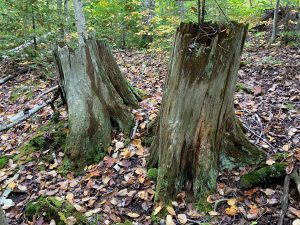
Careful observers can still find centuries’ old stumps scattered through many Michigan forests. While methods and management techniques have changed, lumbering remains an important industry in the state, which is about 54% forested today. After a century of responsible management, replanting, and growth, the Great Lakes State now boasts more than 20 million forested acres which provide homes for wildlife, opportunities for outdoor recreation, and renewable natural resources.
This May 6 – September 4, you’re invited to explore early Michigan lumbering at Historic Mill Creek. Experience the thrill of a water-powered sawmill, make sawdust fly with a pitsaw, and explore a vibrant Michigan forest along three miles of woodland trails. For information, visit www.mackinacparks.com.









